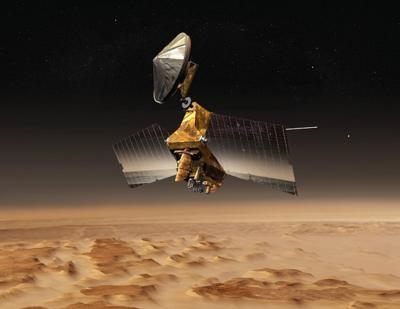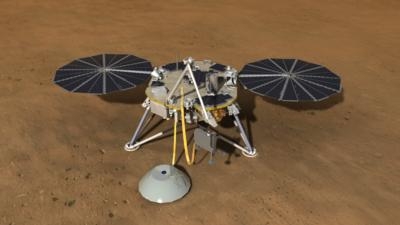InSight Spacecraft Will Reach Mars In 13 Months
NASA's Mars Reconnaissance Orbiter successfully completed a maneuver on July 29, 2015, to put the spacecraft in the right place on Sept. 28, 2016, for supporting arrival of the InSight Mars lander mission. The engine burn began at 6:21:31 a.m. PDT (13:21:31 UTC) and lasted for 75 seconds.

With its biggest orbit maneuver since 2006, NASA's Mars Reconnaissance Orbiter (MRO) will prepare this week for the arrival of NASA's next Mars lander, InSight, next year.
A planned 77-second firing of six intermediate-size thrusters on July 29 will adjust the orbit timing of the veteran spacecraft so it will be in position to receive radio transmissions from InSight as the newcomer descends through the Martian atmosphere and touches down on Sept. 28, 2016. These six rocket engines, which were used for trajectory corrections during the spacecraft's flight from Earth to Mars, can each produce about 22 newtons, or five pounds, of thrust.
"Without making this orbit change maneuver, Mars Reconnaissance Orbiter would be unable to hear from InSight during the landing, but this will put us in the right place at the right time," said MRO Project Manager Dan Johnston of NASA's Jet Propulsion Laboratory, Pasadena, California.
The orbiter will record InSight's transmissions for later playback to Earth as a record of each event during the critical minutes of InSight's arrival at Mars, just as MRO did for the landings of NASA's Curiosity Mars rover three years ago, and NASA's Phoenix Mars lander in 2008.
InSight will examine the deep interior of Mars for clues about the formation and early evolution of all rocky planets, including Earth.
MRO will continue its studies of Mars while preparing for the InSight arrival. MRO collects high-resolution imaging and spectral data, as well as atmospheric and sub-surface profiles. It has returned several times more data about the Red Planet than all other deep-space missions combined. It will also continue providing communication relay support for Mars rovers and making observations for analysis of candidate landing sites for future missions.

After the InSight (pictured in artist's rendering) landing, plans call for MRO to perform a pair of even larger maneuvers in October 2016 and April 2017 -- each using the six intermediate-size thrusters longer than three minutes. These will return it to the orbit timing it has used since 2006, crossing the equator at about 3 a.m. and 3 p.m., local solar time, during each near-polar loop around the planet. To observe the InSight arrival, MRO will be in an orbit that crosses the equator at about 2:30 p.m. local solar mean time.
The last time the mission performed a maneuver larger than this week's was on November 15, 2006. That maneuver fired the intermediate-size thrusters for 76 seconds to establish the original 3 p.m. Local Mean Solar Time (LMST) sun-synchronous condition after a six-month period of using dips into the upper atmosphere to alter the orbit's shape. The spacecraft has three sets of thrusters. It used its most powerful set -- six thrusters, each with 170 newtons, or 39 pounds of force -- for about 27 minutes to first enter orbit when it arrived at Mars on March 10, 2006. It uses eight smaller thrusters most frequently, for small adjustments to course or orientation.
Even after the planned 2017 maneuver, the spacecraft's remaining supply of hydrazine propellant is projected to be more than 413 pounds (about 187 kilograms), equivalent to about 19 years of consumption in normal operations.
(NASA Images)
 Aero-News: Quote of the Day (04.17.24)
Aero-News: Quote of the Day (04.17.24) ANN's Daily Aero-Linx (04.17.24)
ANN's Daily Aero-Linx (04.17.24) Airborne-Flight Training 04.17.24: Feds Need Controllers, Spirit Delay, Redbird
Airborne-Flight Training 04.17.24: Feds Need Controllers, Spirit Delay, Redbird Airborne 04.16.24: RV Update, Affordable Flying Expo, Diamond Lil
Airborne 04.16.24: RV Update, Affordable Flying Expo, Diamond Lil Airborne 04.11.24: SnF24!, King's 50th, Top Rudder, Aileronics
Airborne 04.11.24: SnF24!, King's 50th, Top Rudder, Aileronics




